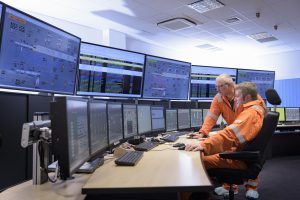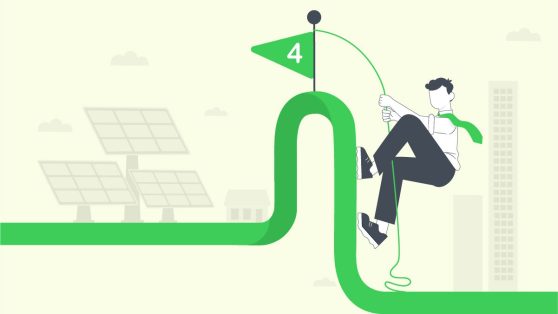Empowering clean energy.
How does AI help to unlock access to clean energy? What are the hurdles in scaling EV adoption and how to overcome them? In the next episode of the AI at Scale podcast Manoj Puthenveetil, Chief Technology Officer at Qmerit, discusses how artificial intelligence can bring more clean energy to our homes.
First, Manoj talks about demands of EV charger installations and challenges that come with it. For example, he highlights expanding electrification projects across North America and the current shortage of skilled electricians. In the second part of the podcast Manoj explains an innovation that supports home charging installation called Panel Insights. He explains how the solution works and how data that we can get from the solution can ease the complexity of understanding one’s home energy needs.

Listen to the AI at Scale podcast
Listen to Manoj Puthenveetil: Driving home on clean energy with AI episode. Subscribe to the show on the preferred streaming platform (Spotify, Apple Podcasts).
Transcript
Gosia Górska: Today, I have the pleasure of hosting Manoj Puthenveetil, Chief Technology Officer at Qmerit. Manoj develops and executes the strategic technical direction of the company and brings innovative products to the market. He has over 30 years of experience leading teams in engineering, product development, product management, UX design, and engineering operations functions. He started as a software engineer and today he is a proponent of customer-centric design, agile methodologies, and blue ocean strategy. Welcome, Manoj.
Manoj: Hello Gosia, excited to be here.
The challenges of electrification and the role of AI
Gosia: Thanks for joining. Let’s start with moving our listeners to sunny California, where the headquarters of Qmerit is located. These are perfect conditions to benefit from clean energy coming from solar panels. As shared on the company’s webpage, you’ve installed more EV chargers and other electrification technologies than anyone else in the industry in North America. Could you tell us how the company started and how it’s doing today?
Manoj: Absolutely. Gosia, I can attest to the fact that it is sunny outside, so we’re very excited to have this great weather back here in the summertime. A little bit too hot though.
Let me give you a little bit more context to who Qmerit is and what we do. We started in the 2014-2015 timeframe, early 2015. We started off as a distributed workforce management company. Essentially, we have a network of electrical contractors nationwide focused on electrification, and we use our digital services platform to bring demand to them so that they can fulfill the requests from end customers.
Over these years, we have done a tremendous amount of EV charger installations—for example, 450,000 plus EV charger installations. We’ve done generator installation, solar system integrations, battery storage installation, and connecting battery and solar together. So pretty much anything in the electrification space is something that we have spent a good amount of time perfecting how to do it here in the US and now expanded into Canada, the UK, and other places.
Pretty excited to be where we are from the humble beginnings of starting as a startup company, and now we’re part of greater Schneider Electric since the last two years.
Gosia: Yes, and it’s actually very topical for us, right? Because at Schneider, we believe that electrification is actually the vector to move to the clean energy sources and to become more sustainable, both for us as a company and for all of our clients. And we have started to use AI to support electrification. And I was wondering, at which stage at Qmerit, you, as the Chief Technology Officer, started to use AI and what was the need behind it?
Manoj: Yeah, that’s a great question. So, look, I’m a huge, huge fan of AI and applying AI in an innovative way, different ways for us to solve bigger problems for the industry.
The interesting thing is, let me just step back a little bit and kind of just explain some of the challenges that we face in today’s world. When you think about electrification, one of the things that we observe, especially here in California—and it is indicative of what is happening nationwide and globally—when people buy an electric vehicle for a variety of different reasons, they may be attracted to buying electric vehicles. Maybe it is the performance aspect of it, it is the driving characteristics of an EV, there could be other factors.
Once they buy, one of the immediate realizations that they come to have is the charging aspect of it, because you’ve got a huge battery associated with that car that needs to be charged so that you can, you know, you can travel places. And as it stands today in the US, the public charging infrastructure is fairly unreliable. That means majority of the charging, 80% to 90% of the charging, is going to occur in people’s homes.
Now, here’s where the tricky part comes into play, or the challenge that really brings about that we can solve with technology. The bigger challenge that people face right away when they think about charging at home is now they have to install a charging station, which draws a lot of current. That means your panel or your electrical capacity, the service capacity, has to be able to support the amount of current that the charger needs to draw. And that brings about a whole bunch of challenges that we need to solve.
So these are things that a regular consumer might not think about right away, but when they buy the car and then they realize that they need to charge, now all of a sudden, the discussion of how do I put a charger in the home comes into play. Understanding various aspects of how you use energy becomes an important topic of discussion. And how do you actually bring this complex topic in a way that consumers can relate and understand and make informed decisions? That becomes a huge challenge, and that is where AI opens certain doors for us to remove friction from that decision-making process. And I can explain that further as we discuss this.
Gosia: Yeah, sure. So on one side, there is this huge benefit and a huge opportunity from the fact that many people are installing solar panels or even wind turbines, especially on the buildings that are owned by organizations, by companies. And then you can use this clean energy also to charge your electric vehicle. But suddenly you have to become an energy expert and almost an electrician as well to be able to manage this to make good decisions. So how is AI helping to unlock this clean energy?
Manoj: Absolutely. I mean, you are onto an exact point that we’re trying to solve for the industry. So if you think about an average consumer who is excited to enjoy their vehicle, maybe that is the starting point. And as our founder and CEO of the company, Tracy Price, says, “The path to winning the hearts and minds of an electrification customer is actually through the garage.” It’s very true in the sense that people can relate to buying an automobile. Now they’ve purchased the automobile, now they got to think about charging.
Once they start to do the charging, now the electricity bill is when they start to see the utility bill and start to see that go up in the direction that they may not have been expecting. And now solar and battery storage and all the other aspects come into play, and you start to think more like an energy consultant and thinking about how your energy usage is within the home.
One of the things, a couple of characteristics that I want to kind of highlight when you think about charging. First, if you think about an EV charger that’s charging an automobile, it essentially is drawing a lot of current for a prolonged period of time. This is unlike your largest electricity usage in California homes might be through air conditioning units or a heating or cooling mechanism that you might have, but even those units don’t spend a lot of time pulling a lot of current in a given day.
But when it comes to an EV charger, it has to. This is a consistent load for a long period of time. And that means you have to think about how do you wire and install, what type of wires you might use, how much capacity exists in the panel. All becomes very, very important.
Today, what happens in the industry is in order for someone to simply come up with an assessment of this is the cost of doing install, or this is how much it will be for you to put together your whole electrification solution, the installers use a method of asking a ton of questions through surveys. And they would be asking lots of different questions, and these questions enable them to understand the electrical load and then ultimately make a reasonable estimate for the customer so that they can make a decision.
Gosia: I can imagine this, like, everyone loves long surveys, right?
Manoj: Yeah. Well, that is, you know, that is a challenge, right? Exactly. So when people have to answer these questions, some of which they don’t actually know all the answers right away, right? And sometimes they have to do this over a long period of time. All of that just introduces friction.
And then the other aspect is, you know, there’s lots of other decisions that you can make in terms of, you know, what type of charger you need to use, what size is the car battery, and that depends on, you know, the car battery takes the time it takes to charge and a whole bunch of other parameters that you want to think about. All of that becomes an easy problem for an AI-based solution to solve.
And that’s where we started to think about applying AI and how do we remove friction from the equation. I think we believe we have solved this problem in the most innovative and effective way, working in collaboration with Schneider’s AI hub, that we think it will be impactful for the industry.
Introducing Panel Insights: AI simplifying EV charging at home
Gosia: So you bring the solution that is called Panel Insights, right? The support for home charging. So for anybody for whom it was easy to buy a car, but not so obvious how to charge and how to actually reply to all these questions, now they can use this solution. And it’s a tool that basically evaluates the electrical specifications, including available circuit spaces, number of tandem breakers. Tell us how it works exactly.
Manoj: Yeah. So one of the things in that long survey that I was talking about, and we call it home energy assessment surveys that we do, one of the things that most surveys ask is what type of loads you have connected. And this is, while it’s a simpler question, it’s harder to get accurate answers.
Now, the way that we’re solving this with Panel Insights AI is we had, over the years, tons of panel images through installations that we have done that we have collected, for which we actually know what the outcome of that installation, the cost of those installations. So we had both the input data as well as the output data that we could use from a training perspective.
And we use the panel images to train a model that enables us to now take a look at a panel picture and immediately assess what type of breakers are in that panel, what type of loads are connected to that panel, what’s the main breaker size, how many open slots exist, and then there is other combination of information, such as solar and generators that may be connected, the brand of the panel. There is a lot more information that we can gather from that panel.
Panel Insights combined with some real estate information that could come from, you know, that could tell us a lot more about the geography and then our empirical data that we have around installation. We can come up with the load sets connected and then use our, what we call a load capacity recommendation engine that does the calculation behind the scenes and says, this is how much load that’s available, how much capacity that’s available for you to use for an EV charging or your electrification project.
Makes the whole decision-making process much more simpler. We’re able to provide a more accurate estimate right up front without asking too many questions and then provide informed guidance to our end customers so they can make the right choice at the end of the day.
Gosia: Yeah, I definitely would love this. I can imagine how easy it must be to just take a picture and send it, and then AI can analyze it and be able to reply to all these questions that I probably wouldn’t be able to answer. I also imagine that for many people who need to face this kind of questions, the easiest solution is to just call the electrician. And I imagine this could also be a barrier because if we really want to scale the solutions and we would like to have more EVs everywhere in the world, so we are using more of the clean energy, this can be also a barrier, right?
Manoj: Exactly. That’s a beautiful point, by the way. And one of the things that we don’t realize and recognize is there is a huge shortage of skilled electricians. And so now you think about this dynamic that’s happening in the market. In one end of the spectrum, there’s this huge demand for electrification projects. People are adopting EVs, thinking about solar, thinking about putting battery storage because of the reliability issues with utility grids, etc.
And so now you’ve got this demand on one side of the equation, and then on the other side of the equation, the skilled electricians are—you know, there’s a shortage of electricians, and this is only, this is not getting better. There are different, you know, actions being taken by government institutions and others to improve the number of electricians. But yet again, the forecasted shortage is a big problem in this space.
So now when a consumer who’s seeking input from an installer, they are not very easily accessible. That’s on one end of the equation. The people who are easily accessible may not be following all the processes if it is cumbersome for them to do so. They may not do proper load calculation, they may not do a proper assessment of the panel because they are simply overwhelmed by the amount of demand that they get. So now what that means is we end up with poorly ill-advised consumers making wrong decisions that result in bigger problems.
So, as I was saying, from a charger perspective, charger draws a lot of current, and if you don’t do proper load calc and you actually load up the panel beyond what it’s supposed to have as capacity or loads connected to that panel, you could be pulling a lot of current, causing, you know, a thermal event, potentially, you know, which could have serious, serious consequences. Right. These are the type of bad behaviors that might end up happening when you have high amount of demand with fewer skilled electricians on one hand, and others are jumping into the fray without actually knowing all the details on how to do it. And it’s set up for challenges that you might not want to see in the industry.
The future of electrification and the impact of AI
Gosia: Yes, exactly. And I think it’s quite obvious that the market will be just growing for the electric vehicles. I just learned that in Warsaw already this year, we will have a clean transport zone in which basically old diesel cars will not be allowed, and this zone will be covering 8% of the city. So naturally, I guess this will also be another incentive for some of the people to jump from their diesel cars to electric vehicles. What other changes do you see in terms of people’s behavior, the infrastructure needs in the future as we see more and more electric vehicles on the streets?
Manoj: And that’s a great point. And look, I think we are in the news. There are different things that come up around EVs from time to time. You know, there are some bumps that we’re facing in 2024, but yet at the same time, when you look at it, the growth is still there. You know, there’s way more choices in terms of EV than we ever had before. There’s way more features that are coming in. There are enough merits for electric vehicles just as is that it is here to stay and start to, you know, start to grow.
From an adoption perspective, it has reached the critical mass that we strongly believe that this is going to be a continued growth. Now, what you see is typically once people get into EV, as you had mentioned before, they become much more aware of their energy usage and start to expand into different aspects of electrification. That’s what you’ll start to see.
More and more people think about solar faster than they would otherwise. The battery storage becomes a big thing. The fact that the batteries in the cars could be used as backup batteries for home through bi-directional capability. There are a lot more bi-directional uses that’s coming into play.
There was a press release from Qmerit around our partnership with GM, for example, where GM’s bi-directional capability—Qmerit is the premier installer for that particular piece. Qmerit, we ourselves have announced Qmerit Powerhouse, for example. This is combining the battery storage, solar, load centers, the smart panels, and other pieces together to offer our consumers a bundle and demystify complexities on how do you bring these different highly sophisticated technologies together in an effective way so that they can adopt electrification.
You probably have heard Tesla and Tesla’s Cybertruck and PowerShare programs where essentially using Cybertruck battery to power the home. Qmerit is Tesla’s Cybertruck PowerShare installer for them. We have done several of those and we continue to do hundreds of thousands of installations for them.
And so as you see the market, there are multiple levels of electrification project applications that you see evolving, all of which that entire experience gets better with the use of AI. And the more we use AI, it not only helps the consumer at the front end of the equation to give them more accurate assessment of how their project will be configured and what it might cost them, it is also enabling us to help the contractors reduce their workload in terms of doing the load calc and creating the best practices iteratively so that they continue to do that and make it easy for them.
And it also helps us do some audits within the network so we can automatically use the information from AI to be able to check the work that is being done by an electrician to make sure that what was originally assessed by AI and what was done are within tolerance and enable us to continue to improve that.
And so I see a future where AI is very much involved in everything that we do, starting with Panel Insights and different applications. That is going to really make the industry better. And that’s what we’re excited about.
Gosia: Yes, I’m also excited about it. And I must say this is my favorite type of technology and innovation that is actually making my life better. If I can breathe clean air, this is exactly the direction that we should be going to. So I really appreciate all your insights. We are coming to the end of our episode. So the last question I wanted to ask will be a bit more personal. Are you driving an electric vehicle yourself? And do you have any recommendations for people who hesitate?
Manoj: I’m glad you asked that question. I got to tell you, I was drawn into EV because of its performance, the capabilities an electric vehicle provides, etc. And so, yes, the first thing is, yes, I do own an electric vehicle. I have a Rivian R1T, which is one of the favorite automobiles that I’ve owned in my life. It actually performs really well. It’s actually a computer on wheels with amazing software updates that constantly improves the capabilities of that vehicle.
So imagine this, and you buy a vehicle in the past before EV, and you get stuck with whatever the features were there in it at that, you know, that day that you bought it until you sell it. With my truck, the truck that I have today has way more features than it had when I bought it. But through monthly over-the-air updates that come to me with so many different features that you wouldn’t even believe that it could be pushed to us.
That’s fantastic. I don’t miss the fact that I have to go to a gas station. I can charge at home. It’s got great range, great performance, etc. So I’m a huge, huge fan of electric vehicles.
As far as recommendations, what I would say is there are so many choices out there. I always recommend for you to go take a look at the options that are available and then consider the charging aspect of it, which is something that you got to think about before you make that investment. And then we’re making that easy for people to make that decision better.
Gosia: Sure. Great. Thank you, Manoj, very much for participating in our podcast. It was a great pleasure to talk with you.
Manoj: Absolutely. I really enjoyed this. Thank you for the opportunity.
Like what you hear?
- Visit our AI at Scale website to discover how do we transform energy management and industrial automation with artificial intelligence technologies to create more sustainable solutions.
- Listen to the other episodes of the AI at Scale podcast.
- Read more about Panel Insights in this press release by Qmerit.
AI at Scale Schneider Electric podcast series continues!
The first Schneider Electric podcast dedicated only to artificial intelligence is available on all streaming platforms. The AI at Scale podcast invites AI practitioners and AI experts to share their experiences, insights, and AI success stories. Through casual conversations, the show provides answers to questions such as: How do I implement AI successfully and sustainably? How do I make a real impact with AI? The AI at Scale podcast features real AI solutions and innovations and offers a sneak peek into the future.





Add a comment